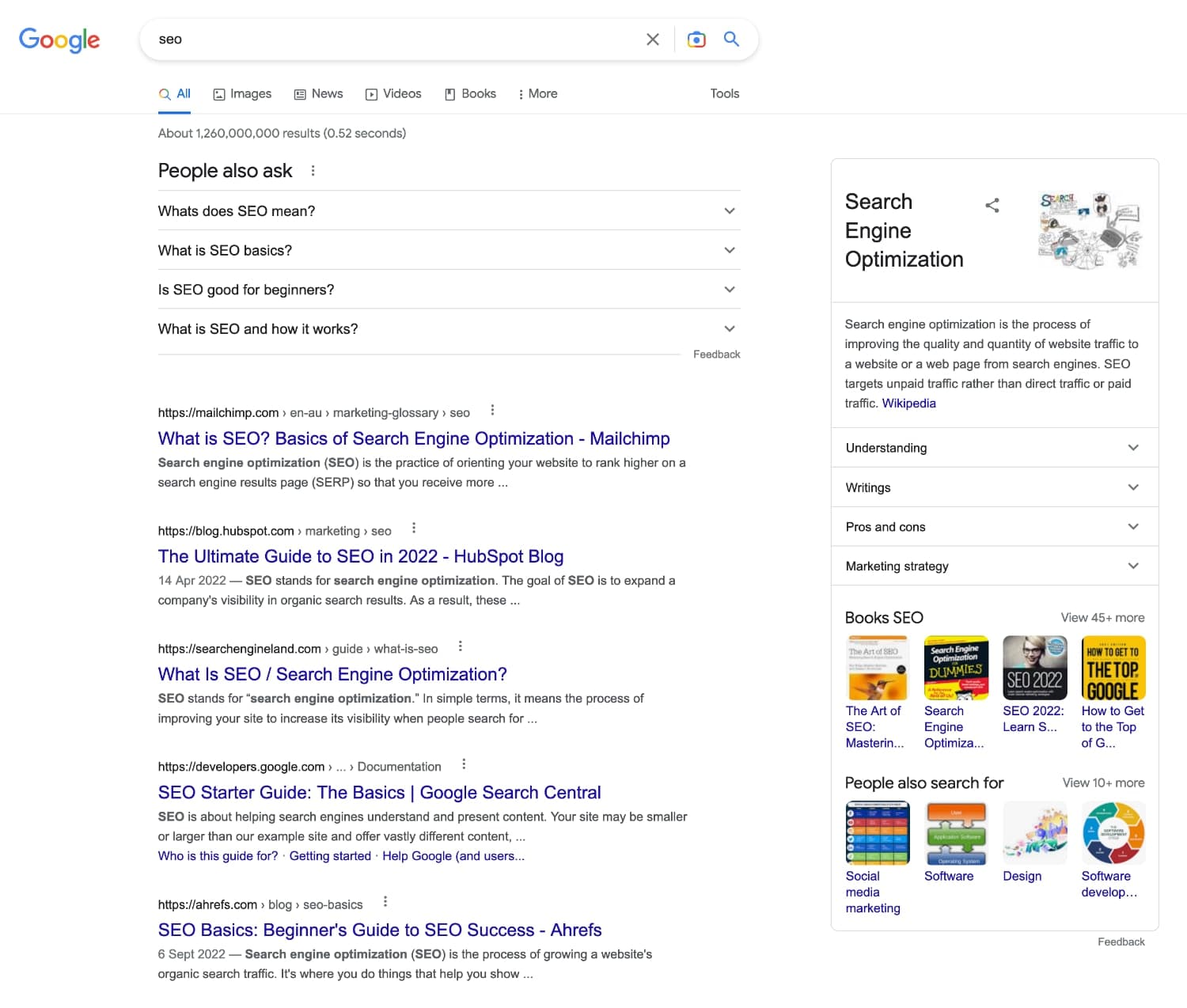SEO Content Has Peaked; it’s Time to Focus on Performance

Karolina Szczur
December 13, 2022
Illustrated by
Increasing organic traffic is supposed to be simple. Write articles with more expert, authoritative, and trustworthy signals than the competition and watch the interested readers pour in. For the lower competition, long-tail Search Engine Results Pages (SERPs), this strategy usually works well enough. However, what happens when every article on a highly competitive SERP is well-optimised, has (the same) insightful information, and comes from well-recognised industry leaders?
Companies need an edge to stand out on competitive SERPs. The current way companies get that edge is with content: ever-growing blog sizes, quicker content update turnaround times, and more promotion. As websites publish more and more content, the question has to be asked: Is there a more efficient way to gain an SEO advantage?
The best way to find that competitive edge is with page performance, a ranking factor explicitly mentioned by Google. Investing in content isn’t a bad idea, but at some point, the benefits of more content don’t make up for the costs of producing and updating it. If you’re looking for a sustainable, under used edge over your organic competitors on SERP, site performance is just the thing you should use to increase your page rankings.
Table of Contents
The problem with “SEO”
The way many websites currently manage their blog is unsustainable. Aggressive content calendars require more and more resources if the company wants to keep quality up. Each new page that gets published will one day need to be updated or risk becoming a drag on the quality and SEO of the blog.
A rigorous content output makes sense if you’re currently involved in a blog like this because more pages equal more authority and more chances to rank. However, once you step back, the problems with this strategy become apparent.
Let’s say your blog currently ranks eleventh for “SEO,” and your goal is to get it to the first results page. Even if you could get it up to the seventh or eighth, that would considerably increase your Click-Through Rate (CTR).

If you view SEO solely through the lens of content and what content brings you, then your strategy to improve your ranking for “SEO” may look something like this:
- Refresh your pillar “SEO” page roughly every year to keep it fresh.
- Use the skyscraper technique to steal backlinks from competitors.
- Increase promotion to build backlinks.
- Create additional content that targets long-tail keywords to build your topical authority.
- Improve internal linking between your relevant posts to pass on link value.
- Audit your blog and refresh or remove thin content.
All of this is good advice, but it requires you to create and edit a lot of content. Over time, the blog will become too much for your team to handle. At this point, the quality slips, topics are repeated, and you’re left with something that slowly becomes more of a detriment than an asset for you. What once was a solid strategy for sustained growth has become a time and resource sink holding you back.
Quality trumps heaps of content
Instead of constantly investing in more content, make the content you already have much better. Start with planning out your site architecture so that there are limits on how big your blog gets. Ask yourself:
- What topics do you need to cover?
- How many posts will be required to cover those topics?
- Which keywords are most essential to your business?
This kind of planning limits the possibility of scope creep, so you don’t end up publishing content ad nauseam for years. If you find your website is already beyond what you need, a content audit is what you’ll need to prune back the excess.
Once you’ve narrowed down what your website needs to be, consider how to make that content as good as possible. Part of this will involve:
- Making better, more informative content by talking to experts.
- Hiring quality writers.
- Creating visuals to help the reader get more from your work.
However, SEO and the overall quality go beyond the content on the page. Google has often stated that they care about not just what you put on the page but how your visitors experience that content. In other words, “quality” includes faster loading, better UI, and robust security measures.
Many established sites are already making some fundamental changes to improve user experience qualities, like:
- Upgrading to HTTPS
- Removing popups
- Making your site more mobile-friendly
However, one area of quality many websites seem to need to pay more attention to is web performance. Often viewed as too difficult, improving your page speed and responsiveness is often neglected for lower-hanging fruit. However, this neglect is also your opportunity to outdo your competitors.
Web performance is just as important but less contested
Web performance is an essential indicator of quality for Google. They’ve recognised that “users … prefer sites with a great page experience,” and page speed (specifically the Core Web Vitals) is an essential part of that.
However, despite this, there are still a lot of professional websites that haven’t gotten the message. A full 50% of the articles on the first page of the “SEO” SERP failed our Core Web Vitals Assessment. This is on a SERP full of companies that presumably know a thing or two about SEO, so imagine the pass/fail rate for a less known niche.
| Rank | Core Web Vitals Assessment | LCP | CLS | FID |
|---|---|---|---|---|
| #1 | Failed | 3.08s To improve | 0.08 Good | 0 Good |
| #2 | Failed | 3.31s To improve | 0.04 Good | 13ms Good |
| #3 | Failed | 2.09s Good | 0.30 Poor | 9ms Good |
| #4 | Failed | 3.08s To improve | 0.16 To improve | 12ms Good |
| #5 | Failed | 2.62s To improve | 0.11 To improve | 10ms Good |
Core Web Vitals data from Chrome User Experience Report (CrUX), checked with Core Web Vitals Test on December 13, 2022.
The logical conclusion is almost too good to be true: web performance is an essential ranking factor many people aren’t optimising. Not only that, improvement is measurable. You can easily see how your competitors’ pages do and then make sure to outperform them, so if you invest in speeding up your pages where it matters and pair that with quality content, you’ll be well on your way to better SEO results.
Page speed as a ranking factor isn’t the only reason you should speed up your web pages—your site visitors will thank you, too. Report after report shows that people prefer sites that load quickly:
- Over 50% of visitors won’t wait more than six seconds for a page to load.
- 70% of visitors said slow pages made them less likely to purchase from a website.
- For every one-second improvement in page speed, conversion rates increase by 17%.
Happier visitors help your bottom line and send positive signals to Google. If readers click through and stick around or even buy something, then Google knows that their intent was successfully satisfied.
Improving performance is easier than many think
The developmer-centric nature of site speed optimisation shouldn’t scare you from making improvements. You’ll need someone with enough knowledge to implement these changes to your website, but most teams already have access to someone like this. The larger roadblock many companies face is getting buy-in across the entire organisation to prioritise site speed.
Some ways to start making changes at an organisational level include:
- Creating speed teams with members from different departments
- Setting achievable performance budgets as goals to aim for
- Educating team members on what they can do in their role to contribute to faster pages
Along with these more considerable picture changes, you should also explore specific tactics that’ll help speed up each of your pages. These include:
- Improving CSS performance with changes like using efficient animations and minifying or compressing files
- Reducing your JavaScript files through bundling and lazy loading
- Optimising your images for faster load times with compression tools and the most efficient file types
Even if you successfully implement only a few of these optimisations, you’d be doing more than many websites. Plus, once you get started and see the results, you’ll have all the motivation to dive deeper and experiment with speed optimisation techniques.
Take the advantage your competitors aren’t brave enough to
No one says you should cut your content budget to zero and invest 100% in web performance. You’ll always need good content to rank well and bring in new readers. However, when considering how to get the most out of your organic traffic budget, web performance over excessive content is the obvious choice.
Web performance is a key ranking factor. It improves UX, and it’s a change that won’t be “out of date” or need to be refreshed six months from now. Every dollar and hour spent making your pages faster is a win for your SEO, readers, and business.
The best way to get started on improving your web performance is to give a performance monitoring tool like Calibre a try. With Calibre, you can test pages for site speed problems, identify problematic third-party scripts, and even test changes to your site before they go live.
To get started, sign up for our free 15-day trial. To learn more, take a look at how Calibre can help you, specifically, regardless of whether you’re an SEO, a developer, at an agency, or part of a product team.
Get the latest performance resources, every two weeks
We will send you articles, tools, case studies and more, so you can become a better performance advocate.
“This newsletter is easily the best performance publication we have.”
Harry Roberts
Consultant Web Performance Engineer